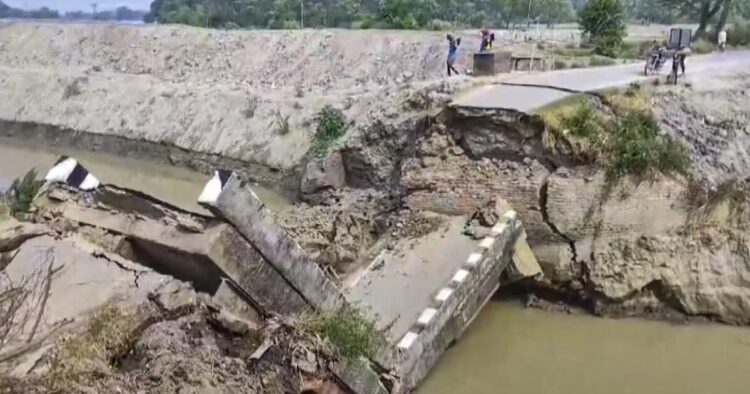On Wednesday, four small bridges collapsed in Bihar, with three in Siwan district and one in Saran district. This has brought the total number of bridge collapses in the state to nine since June 18.
The Nitish Kumar-led Bihar government has ordered an investigation into these incidents and has requested detailed reports from both district administrations. Fortunately, no casualties have been reported in these recent collapses.
Since July 18, bridges have collapsed in several districts including Kishanganj, Araria, Madhubani, East Champaran, and now Siwan.
In Siwan district alone, three bridges collapsed on Wednesday. One bridge, built in 1998 over a Gandak river stream in Maharajganj’s Deoria Panchayat with a fund of ₹6 lakh from the Member of Parliament Local Area Development (MPLAD) scheme, was among those that fell. Another bridge, constructed with ₹10 lakh from the MPLAD fund in 2004, collapsed at Nautan Sikandarpur over the Dhamahi River. The third collapse in Siwan occurred in the Teghra area.
In Saran district, a portion of a 150-year-old bridge in Damdaspurpur also crumbled on the same day.
The state’s water resources department has instructed chief engineers to closely monitor the water levels of North Bihar rivers, which have been receiving additional water due to heavy rains in Nepal. The incessant rains have led to increased water discharge, which might have contributed to the bridge collapses.
ALSO READ: “NEET-UG Case Developments: Suspects Brought to Special CBI Court in Patna, Bihar”
RJD leader and former deputy chief minister Tejashwi Prasad Yadav criticized the state government on social media. In a post on X, he highlighted the collapses and questioned the accountability of the NDA government at both the state and central levels.
A leader from the JD(U) responded by stating that the state has ordered inquiries to uncover the reasons behind the collapses. They suggested that the causes could include the heavy rains and the excess flow of water from rivers originating in Nepal.
As investigations continue, the focus remains on ensuring the safety and stability of the remaining infrastructure in the region, particularly with the ongoing heavy rainfall.

















Comments